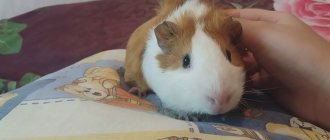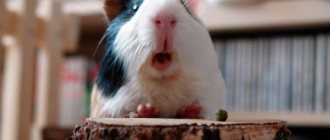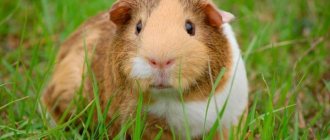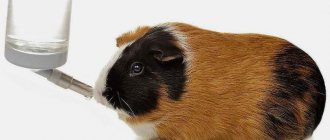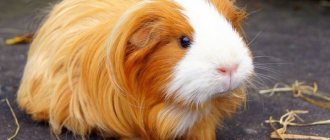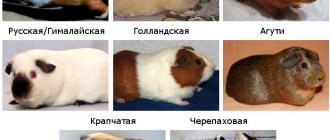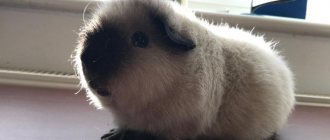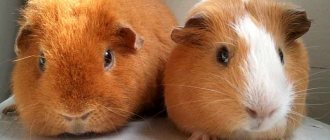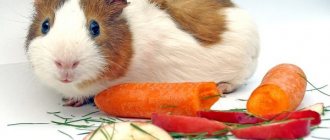Some behavior traits of guinea pigs can amaze even experienced breeders, while beginners can be completely shocked when trying to understand the strange behavior of the rodent.
When owners see a pig jumping or twitching for the first time, they often think that their animal is sick with something.
Popcorning is a behavioral feature of a rodent that causes an excited and playful state. This phenomenon occurs mainly in young animals under the age of one year, but it can also be found in older pigs. In this article you will learn everything about this unusual behavior of the animal.
Features of behavior
By nature, guinea pigs are not aggressive creatures. Sometimes they sort things out in rare fights, establish a hierarchy, or simply defend their personal boundaries. However, clashes between animals are quite rare. The only exception is the Kui guinea pigs, who are quite militant not only towards each other, but also towards the whole world.
Most often, the animals are in a joyful and playful mood, willingly making contact with the owner, communicating with relatives.
But sometimes you can notice that the animal looks sleepy or snarls when trying to pet it, hides in a corner and sits with a ruff, and refuses the offered treat. This condition indicates the presence of diseases. The animal must be examined and, if necessary, shown to a veterinarian.
If the guinea pig squeals and twitches while the owner is petting the pet or scratching its tummy, then there is no need to worry. The animal is not sick. This is how he expresses his pleasure. Sometimes satisfied pigs can rumble or grumble, and even lick the owner's hands in response to pleasant actions. An interested animal grunts funny. They make similar sounds when communicating with each other.
Article on the topic: Anatomy and skeleton of a guinea pig, internal and external body structure
Beginning breeders are often frightened by the strange behavior of animals: the pig runs around the cage, jumps, kicks, shakes its head and squeals. Some believe that the animal is sick, while others believe that something is bothering the pig or that it is scared.
This behavior is called popcorning and has a very positive explanation.
Teaching proper manners
If the animal bites (not in the form of a show of love, but in real pain), you need to carefully place it back into the home. In subsequent communications, you must be extremely careful.
It is important to monitor which parts of the pet’s body are touched by the animal, and which parts, on the contrary, cause discomfort and cause protest on the part of the little pet.
Manifestations of friendliness in the behavior of a pet should be encouraged - give the animal treats. Gradually, the duration of the communication session with your pet should be increased.
The greatest result of taming is achievable while the animal is in childhood
That is why it is important, even in infancy, to accustom your pet to unpleasant procedures and processes necessary for care and maintaining hygiene. To minimize stress, you should follow simple rules:
- do not force the animal if it shows strong dissatisfaction with what is happening;
- eliminate external stimuli (sources of noise, etc.);
- do not disturb the animal during the adaptation period.
How to tame
Competent training is carried out like this:
- A finger is placed on the cage and removed if the pig shows aggression. The animal needs to say “no” - in a firm voice, but without raising the tone.
- The pig is given a treat, after which the finger is again applied to the bars of the cage. If your pet tries to bite again, you need to show him the gift, but you cannot give it away.
This process must be repeated every day until the result is achieved - the animal stops trying to “grab” the finger. Treats are the best motivation for a small rodent in any circumstances (reviews from owners are the main confirmation of this). The success of training will not be long in coming.
Popcorning
There is no need to look for reasons why a guinea pig jumps like mad around the cage due to diseases and disorders of the nervous system.
A guinea pig will only popcorn in a state of absolute pleasure, good mood and happiness.
Most often, popcorning in guinea pigs is observed at an early age, when the animal is full of energy and strength, however, an adult pig periodically jumps around the cage, making funny sounds and shaking its head. Often the females begin to jump around the cage after their frolicking cubs, and soon you will notice that the whole family of pigs is jumping merrily, squealing and kicking their hind legs. The name “popcorning” was invented by the Americans. They associated the unusual behavior of the happy animals with corn kernels bouncing in a frying pan while making their favorite popcorn.
Natural reaction
In most cases, the answer to the question “why is a pig jumping” is that this is normal behavior for piglets. As a rule, young animals are prone to such actions. They become happy, they run around the cage and make noise. They can even rock the cage. Some pigs whistle at this.
If there are several individuals in the cage, then representatives of the older generation can also join in the fun of the piglet. After this warm-up, which can last 5-10 minutes, the pigs rest, eat and drink water.
Bad habits of guinea pigs
Keeping animals in cages without the opportunity to walk and communicate can lead to the development of many bad habits. A confined space causes severe stress in animals. Stress can be determined by the loss of appetite, and by the depressed state, and by the fact that the pig has begun to gnaw on the bars of the cage, feeders, drinking bowls, and even the house. Normally, pigs try to taste all surrounding objects - this is normal.
However, if the animal purposefully and concentratedly destroys objects, this indicates a state of stress.
If a pig is left alone for a long time and not given the opportunity to run and jump freely, this can lead to aggression and withdrawal. All guinea pigs are very social and sociable by nature, but if you don’t pay attention to them, they lose trust in their owner and can start biting, running away and avoiding human contact. Keeping him in a very cramped cage will also provoke the development of the habit of gnawing on the bars of the cage and all surrounding objects, and a reluctance to return to the cage after a walk, which will be shown in fights with the owner and sharp squeaking.
Related article: Do guinea pigs bite or not? What to do if you are bitten until you bleed and how to stop a rodent from biting
If the animal shows displeasure from the conditions of detention, it is worth changing the pig’s lifestyle, and not think about how to wean the pig from gnawing rods or biting.
- Buy a large cage (for one pig, the optimal cage size is 70 cm by 100 cm),
- Buy a couple for a bored animal (not necessarily an individual of the opposite sex, same-sex pigs get along well with each other),
- Provide a balanced and varied diet,
- Provide a daily opportunity to walk around the room sufficiently,
- Buy a few special toys,
- Pay more attention: scratch, stroke, talk, give treats.
If you don’t have enough free time, it is recommended to purchase a much larger cage or even a two-level one. Divide the feeding and playing areas inside, as well as an area for relaxation and sleeping. Install several mazes, hang smart toys with food inside and several comfortable hammocks. It is important to hang the hammocks as comfortably as possible for the animal, since its legs are very fragile and are not intended for high-altitude jumps. A fall from a high hammock can also result in injury. In such a cage the animal will always find something to do.
Not enough vitamins?
Don't forget to feed your pet with vitamins. The animal itches, has a rash on its skin, and hair falls out. The pet is apathetic and inactive. Sometimes he gets constipated.
If a concerned owner takes a sick pet to the veterinarian, and the tests done do not confirm the presence of any parasites, a diagnosis can be made: vitamin deficiency. Most often it manifests itself in the winter-spring off-season and is associated with a lack of succulent feed containing vitamin C.
What to do in this case? Treatment is extremely simple: you need to increase the portions of such feed. You can also add ascorbic acid to drinking water - no more than 1 mg per liter of liquid.
Experts highly recommend placing a bunch of fresh parsley in the cage, rich in this vitamin and loved by guinea pigs.
It is also necessary to provide the sick rodent with a quiet and warm place so that the weakened body does not catch a cold, which can lead to pneumonia.
Contacting a veterinarian
However, sometimes an animal’s unusual behavior can also mean health problems. If the pet jumps around the cage, lies around, itches itself on everything, and the fur looks dull, begins to fall out and bald patches appear - this indicates the appearance of skin parasites. An animal can become infected with them not only by walking down the street. Often flea or tick larvae get to the animal along with low-quality hay or bedding, as well as poorly washed food. If your pig shows anxiety and loses his appetite, you should consult a doctor. Analysis of the skin scraping will determine both the type of parasite and the degree of infection.
If all the conditions of keeping are met correctly, the pig receives a lot of attention and has a large living space, but suddenly it starts gnawing on cage bars or other objects - this may indicate problems with teeth or the presence of intestinal parasites. You can determine a worm infestation by carefully examining your pet's stool—most often, eggs or adult worms are found in the feces. For treatment, you can use Shustrik paste, which is sold at any veterinary pharmacy. If your pig has dental problems, then a visit to the doctor is a must.
Article on the topic: Characteristics, behavior and intelligence of guinea pigs
Most often, in this way the animal tries to grind down excessively long incisors, which cause discomfort. In other cases, the animal tries to get stuck pieces of food or shows that its teeth are not properly rooted. Correcting a bite can only be done in a veterinary clinic. The procedure does not take much time and brings instant relief.
conclusions
Guinea pigs jump because of joyful events or because of health problems. To determine the cause, it is necessary to monitor the behavior and condition of the pet. If you purchase a rodent from other people, you should find out whether the animal has been trained. Then the owner will not be concerned about the pet’s strange behavior.
Guinea pigs are rightfully considered one of the most unpretentious pets.
They ideal for keeping them at home: they are small in size, they don’t eat that much, they don’t run around the house and they can be placed in a small cage.
And their care is practically minimal. Guinea pigs are very friendly, they rarely bite, which means they are not dangerous even for the smallest members of the family. Pigs are very gentle and affectionate, calm, the main thing for them is delicious food and a clean home.
Although sometimes strange things happen to the cutest creatures in the world. Suddenly the pigs may start jumping and running around the cage, making a lot of noise. If you have recently brought such an animal into your home, then you will immediately wonder why such metamorphoses suddenly begin to occur with a calm animal.
Some owners panic, thinking that their four-legged friend has gone crazy, while others, on the contrary, rejoice, claiming that if their pets are active, then they are healthy.
What actually happens to guinea pigs and should you worry when they start jumping and running around the cage very actively, creating noise that is so unusual for them?
In reality, everything is not as scary as it seems. When your guinea pig starts running and jumping around the cage, this should not bother you, he is happy about something and there is nothing wrong with that, in this way the rodent shows others that he is happy.
Why does my guinea pig jump around the cage and twitch?
Popcorning is a phenomenon in which a rodent begins to behave like popcorn—bouncing. Why does a guinea pig jump around the cage? - This is a sign that she is well. In this way she shows her good mood and love of life. This is usually characteristic of young individuals. But if several generations live in the pen, then mature males and females begin to frolic together with the young guinea pigs. When a guinea pig runs and jumps, metabolic processes in its body improve. If she has little space or is not allowed to run around the room, then this is her way of toning herself up in a cage.
But sometimes the jumping and skipping looks more like anxiety than fun: as if she is dodging something. Why does my guinea pig itch and jump? - Because there are fleas, lice eaters or ticks in her fur. A particularly violent reaction is observed when this is the first time in a guinea pig’s life. In such cases, the owner’s task is to quickly examine the animal and, if exoparasites are present, take appropriate measures.
Video of guinea pigs popcorning:
The peculiarities of rodents manage to surprise even experienced breeders, and beginners are completely stumped when trying to figure out why a guinea pig jumps, twitches and shakes its head.
Article on the topic: Why is the guinea pig called that, the history of the origin of the name
Faced with this behavior, inexperienced owners are horrified and suspect rabies and other incurable diseases.
Let's figure out what this behavior of the animal means and whether there are good reasons for panic.
Return to the cage
If your guinea pig is jumping around the cage, this may be a reaction to the animal returning to it after a walk. Familiar smells and surroundings bring the animal into joyful excitement. This reaction is normal, so the owner should not worry. It happens that a pet constantly jumps off his hands, and the owner approves of this. Under no circumstances should you allow your pig to behave this way. If she actively jumps from the owner's hands into the cage and back, she may injure herself on the bars or injure her paws. Therefore, it is better to wean the animal from a bad habit.
The pet must be held tightly when inserted into the house, but not released. The pig will have to be held until it calms down. Then the rodent must be quietly placed on the floor. Do not put pressure on the animal's back to avoid damaging the spine. If the pig still breaks out of your hands, you will have to repeat your actions a couple of times.
Basic moments
Crazy jumps around the cage are not a cause for concern, but a reason for joy. The galloping animal is not sick, but happy and splashes out its accumulated energy.
Popcorning is crazy jumps and somersaults
Strange actions performed by a pet are called popcorning. The choice of name was due to the amazing similarity of rodents to corn kernels bouncing in the microwave while popcorn is being made.
Funny behavior is common to all ages, but is more common in young individuals.
Pig shows last about 5 minutes and include:
- jumping and turning over in the air;
- dancing using the fifth point;
- squeals, squeaks and other crazy sounds of delight;
- falls and febrile convulsions;
- cutting circles at the incredible speed of a racing car.
If the pig runs around like crazy and successfully involves other cage inhabitants in its madness, then release the animals to freedom. After expanding the territory, the rodents will quickly calm down and fall into deep sleep, replenishing the energy expended.
After a burst of energy comes a sound sleep
Natural reaction
Sometimes the reason why your piggy is jumping can be due to its natural behavior. Most often this occurs in young individuals. The animals show their cheerful mood in this way, frolicking and rushing around the entire cage. Some rodents can rock the cage, making whistling sounds. If, in addition to the young pig, there are older individuals, then they begin to repeat after the young pig. The unusual behavior may last about 7-15 minutes, after which the pet either begins to drink and eat, or rests. This phenomenon among healthy pigs is called “popcorning.” The way they jump can be compared to the exploding kernels of corn when they are fried.
Reasons for crazy racing
As you try to figure out why your pet jumps up and down while performing exciting tricks, consider recent events that pleased your pig:
- receiving treats or a new portion of hay with a fragrant smell;
- the opportunity to walk outside the usual conditions and other amenities depending on the characteristics of a particular animal.
IMPORTANT! Popcorning in guinea pigs is contagious! If “seizures” begin in one animal, then the rest will soon follow. Don't worry, because the joy hormone prolongs life.
If none of the above actions have been performed, then think about the convenience of keeping a pet. A cramped room, deprived of additional space for play, literally puts pressure on the animal, depriving it of the opportunity to stretch its legs. Over time, lack of activity leads to running in one place.
Article on the topic: Gray giant rabbit
Try changing the usual house for a larger living space containing tunnels, a wheel and other toys.
Negative signals
A frightened guinea pig will say a dull “Urrrr”, similar to a vibrating alert on a phone, and will tremble slightly. But she indicates irritation with a short sharp squeal - for example, when you carelessly touched her. If the pig is angry, it squeals for a longer time, while clicking its teeth, as if warning: “I’m not in the mood for jokes!”
One of the most impressive sounds a pig makes can be heard at night. This is a very sharp intermittent squeak, similar to the cry of a bird caught in a snare. At the same time, the pig freezes in place, her gaze glazes over. An inexperienced owner may be afraid for his pet. This sound is used by pigs to call their relatives. Little pig babies can express their fear this way.
Since guinea pigs are herd animals, they find it sad to live alone. If your pig makes this noise frequently, try petting your pig more often or give him a buddy in his cage.
If the pig is hungry, you won't miss it. She will stand up and scream shrilly throughout the apartment: “Wee-wee-wee!”, moving her ears. It’s amazing how loud such a small animal can be! Guinea pigs study their owners. They usually remember sounds, such as the sound of a knife hitting a cutting board when preparing a salad or the rustle of a bag from which cabbage is taken out. Subsequently, upon hearing these sounds, the pigs whistle invitingly. They also have a well-developed sense of smell. So you’re unlikely to be able to quietly snack on a cucumber; the alarm will immediately go off!
Popcorning in guinea pigs is a condition of an animal in which its behavior is, at first glance, inappropriate: chaotic running, jumping, convulsions. This looks unusual, but should not cause panic. This playful state is natural and safe. However, its signs are similar to those of some diseases, so it is important to correctly interpret your pet’s behavior.
Similar cases requiring medical diagnosis
Please note that the actions performed during popcorn are similar to the symptoms of certain diseases:
- Blood-sucking parasites (ticks, fleas). If the animal scratches itself on all objects in the cage, and its fur loses its usual shine and begins to fall out, then contact a veterinarian. Infestation with larvae can occur through hay.
- Worm infestations. A sharp loss of weight and the appearance of inclusions in feces are alarming signs of helminthiasis. It is not difficult to see eggs or adults, so be sure to check your pet's stool.
- Dental diseases. If a pig runs around and tries to chew through the bars, it means it has problems with its incisors. Be sure to take your pet to the clinic to rule out problems with stones or improper growth of the roots of the teeth.
Diseases
Sometimes endoparasites or lice eaters can get on an animal's fur. They cause itchy skin. Therefore, the guinea pig itches and jumps, and also makes other restless, chaotic movements. In addition, the animal often shakes itself.
It is important to regularly check the condition of your pet's coat, especially for long-haired breeds. You need to examine your skin at least once a week. The onset of the disease may be accompanied by redness and peeling. Later wounds appear. If such symptoms are detected, you should consult a specialist. Help can be provided by a veterinarian who will select the necessary medications and prescribe the necessary treatment.
Why does a guinea pig jump?
I hasten to reassure you, popcorning is a behavior quite typical for guinea pigs. And quite funny and funny, I must say! Some pigs can jump into the air with their whole body, and some can alternately kick their front and back legs. Pigs often make a characteristic sound when doing this.
Popcorning is a common occurrence for young pigs. Adult guinea pigs will also popcorn, although usually not as often, and they do not jump as high as juveniles.
Article on the topic: Do fish and turtles get along in the same aquarium together, with whom can you keep turtles?
“Why is my pig jumping? What is the reason for this behavior? - you ask.
Popcorning is a behavior characteristic of guinea pigs, when the animal expresses its joy and good mood by jumping.
When a guinea pig jumps, it is the first sign that he is very happy and excited. This behavior can be observed when you give your pigs fresh hay or a tasty treat, or even just walk up to the cage and start talking to the pig.
Breeders often want to demonstrate the effect of popcorn to friends or film this funny spectacle, but, unfortunately, it is not possible to force a pig to “popcorn” on command. The pig does it according to his mood, so to speak. The best way to encourage them to jump is to do things that make them happy, such as feeding them well, spending time with them, playing and talking to them. And then the pig will delight you with its happy jumps!
Guinea pigs usually behave calmly and evenly, but sometimes their behavior deviates from the usual. They may begin to behave inappropriately and in a frightening manner: jumping, continuously running around the cage, twitching, etc. There is no single answer to why a pet loses self-control and begins to behave so strangely. Such manifestations can be caused by various reasons.
The reason that a guinea pig jumps and twitches may be endoparasites (lice eaters, ticks, fleas, etc.) that have gotten onto the pet’s fur coat or the surface of the pet’s body. Parasitic insects provoke skin itching, so restless behavior is usually accompanied by scratching and shaking the fur.
Regular skin examinations and checking the condition of your pet's coat will help prevent the development of diseases caused by endoparasites. It is especially necessary to carry out examinations of long-haired pigs. Thorough inspections should be carried out at least once a week.
Article on the topic: Why does a guinea pig chatter its teeth, what does it mean?
Already at the initial stage of the disease, the pet’s skin turns red and peels, which later transforms into wounds and damage. If you notice these symptoms, you should immediately show your pet to a veterinarian. Only a doctor can specifically identify the causative agent of the disease, select the necessary medications and prescribe appropriate therapy.
If an animal twitches and jumps, this is not always an alarming signal. For most rodents, this behavior symbolizes joy. Especially often, such attacks of unbridled fun, when the whole cage is shaking from the “raging” little pet, happen in young animals.
Moreover, they infect all their neighbors with a violent attitude, regardless of their age. All young and adult pigs join in the fun. Therefore, the more individuals live in one cage, the more stormy and noisy the “party” will be. In the process, the guinea pig jumps around the cage, runs, whistles, shakes its head and even rocks its home.
This phenomenon is called “popcorning” (derived from popcorn). The name is apt - the static corn balls begin to bounce and flop around as they heat up while popping popcorn.
There is no need to worry about this behavior of pets, you just need to wait it out. In 5–10 minutes the “holiday” will end, the rodents will rest, eat and drink - in a word, gain strength.
Another common reason for guinea pigs to jump is when returning to their home. Sometimes they begin to jump for joy even before they get into their home cage, that is, in the hands of the owner. It happens that the pig jumps from the owner's arms. Some owners not only do not interfere with this, but even encourage the impulses of the “sports” pet. But with such jumps, a pet can easily harm itself, get injured or bruised.
To prevent this, it is important to wean your pet from such tricks. To do this, you need to firmly but carefully grab the animal with your hands and place it in such a “trap” inside the cage. The pig should be kept at a height of several centimeters from the bottom. It is important not to unclench your hands until the pet calms down. Then the animal is placed on the floor of the cage, but is not completely released until it stops twitching and struggling. When the pig finally calms down, you can give her freedom. If necessary, the lesson is repeated.
Article on the topic: What to do if a guinea pig’s eye is festering or watery - treatment and symptoms of possible diseases
Among other reasons why a pig begins to behave strangely, it is worth noting a lack of exercise. If your pet has no place to stretch his legs and run around to his heart's content, he will begin to jump in place and run at jet speed around the cage. To prevent the lack of physical activity from negatively affecting the health of the animal and the general condition of its body, it is worth at least from time to time letting it out of the cage for a walk - jogging across a wide area will benefit the pet.
If running around is interspersed with breaks, during which the animal gnaws at the cage, this is a reason for concern and contact a doctor. Your pet probably has dental problems.
If restless behavior is combined with lethargy (for example, the pet lies on its side and twitches, etc.), there is a high probability that the animal has ectoparasites (that is, internal ones). If such manifestations occur, you should immediately show the rodent to a veterinarian. Otherwise, the pet will die.
When an animal displays inappropriate behavior, you should not panic or, on the contrary, not pay attention to it. It is important to competently and judiciously evaluate all the characteristic signs. It is not difficult to distinguish fun popcorn from symptoms of the disease. The main thing is to do it correctly and in a timely manner.
Similar articles:
Why was the guinea pig called the sea version? Why is the guinea pig called so - guinea pig? Like a distant rodent...
Rex guinea pig Rex is a short-haired breed of guinea pig, since the length of their fur is not...
Types of marine fish and their habitat features Sea fishing differs from fishing in fresh water bodies. Fishermen choose others...
Return to the cage
Another option when a guinea pig jumps is to return the animal back to the cage. The rodent enjoys familiar surroundings and smells; this is also a natural reaction of the pig and there is no need to worry in this case.
Sometimes it happens that a guinea pig jumps out of the owner's arms, and the owner allows and even encourages this behavior of the animal.
Remember! Your pet may fall and injure its paws if it actively jumps from your hands. Therefore, he should be weaned from such behavior in the future.
To do this, holding the animal tightly, you need to stick your hands inside the home and hold them a few centimeters from the floor. The pig needs to be held until it calms down. Then carefully place the pet on the floor, but do not let go until the rodent gives up its attempts to escape from you. You need to hold it carefully so as not to damage the back. This lesson may need to be repeated several times.
Help, the barnacle is constantly twitching.
Help, the barnacle is constantly twitching. ¶
My pig constantly twitches and jumps as if she had been stung, sometimes she falls over on her side. What with her?
Help, the barnacle is constantly twitching. ¶
Most likely it's popcorning. Read about it on the forum.
Article on the topic: Why does a guinea pig lick its owner’s hands: reasons
Help, the barnacle is constantly twitching. ¶
It would be nice to describe in more detail what it means to twitch, with one paw, with all of them, with the belly, with the head, and how it breathes, especially when it falls over on its side. Maybe there are some sounds.
Help, the barnacle is constantly twitching. ¶
I haven’t seen a pig fall on its side while popcorning. He just bucks and gallops like an unbroken mustang on the prairie. Rolling onto your side is a strange symptom, please describe it in more detail.
Help, the barnacle is constantly twitching. ¶
As soon as I let her out of the cage, he starts jumping and galloping like crazy and collapses on his side in his arms. And in the cage he only jumps sometimes. Although he's been quieter lately.
Help, the barnacle is constantly twitching. ¶
It seems to me that this is simply due to the young age of the pig and, as they wrote, popcorning. And not the least important role is played by the fact that, apparently, the pig is not very tame yet. When she gets used to you, everything will become much easier.
Help, the barnacle is constantly twitching. ¶
Yes, if he falls over on his side in his arms, then it’s not scary, most likely popcorn. At first I thought that the pig on the floor was falling on its side! laughter
Help, the barnacle is constantly twitching. ¶
From: Zyazya - March 17, 2005 3:16
Nauria, Zyazi had the same thing. We went to the veterinarian and the doctor said: For 2 weeks, feed Zyazya from a syringe 2 times a day with a chamomile solution.
Now everything is fine again. It’s just “To increase the internal flora”, that’s why the pig was twitching. [ 16 March 2005, 18:16: Message changed: Zyazya ]
How does it manifest?
Popcorn attacks can cause fear and panic in an inexperienced owner. At these moments the animals:
- quickly run in circles;
- jump and twitch while jumping;
- they squeak and squeal loudly;
- periodically fall;
- shaking and turning their heads.
The process lasts 5–7 minutes, but there are also protracted cases. There is no need to be afraid of such scenes. This is not a sign of rabies or mental problems, but a natural manifestation of increased excitability of the animal. In such cases, the pig is released from the cage so that it splashes out energy and does not get injured in a cramped space. After the “fun” the animal calms down and falls asleep. Young individuals are susceptible to attacks more often than adults.
Expert opinion
Experts say that guinea pigs periodically eat their droppings to restore their intestinal microflora, just like other herbivores. This phenomenon is called coprophagy, it is considered completely normal and physiologically necessary for life, so there is no need to prohibit animals from doing this.
Zoologists claim that the microflora of the guinea pig’s cecum synthesizes substances necessary for the body:
- enzymes; B vitamins; amino acids; vitamins K.
At the first meal, these microelements are not absorbed in the body, so animals eat their feces and reabsorb the substances they contain.
Initially, rodents eat grass, hay and food, which contain a large amount of fiber, which does not have time to be digested immediately. As food particles pass through the gastrointestinal tract, they are influenced by bacteria, which break down food into amino acids. After the waste products have come out, the animal eats them, and all the substances are normally absorbed in the body for the second time. Thus, the pet's intestines will function normally.
Necessary for care
Like any other pet, a guinea pig requires a wide variety of grooming accessories. These include:
- cage or aquarium;
- feeder;
- sippy cup;
- house;
- filler;
- mineral stone;
- toys;
- carrying;
- hygiene products;
- brush-comb and nail clipper.
Cage or aquarium
Keeping a guinea pig is allowed both in an aquarium and in a cage. The main condition is size: the dwelling must be at least 50 cm in length and 30 cm in height so that the animal can move comfortably. If you have decided on a cage, then it is best to take a closer look at the options that have a plastic bottom. Plastic is quite easy to care for, it is easy to wash, dry, etc. A wooden base is not suitable due to the fact that these animals drink a lot of liquid per day, and therefore excrete a large amount of urine. The wood will simply become unusable in a very short time. You can purchase an aquarium in the above sizes. It, like a cage with a plastic bottom, is easy to wash and clean. But you should be careful, since glass is a very fragile material and when moving it, for example, to another room, you should follow safety rules (the pet should not be in the aquarium, it should be transferred to a carrier).
cell
Feeder
The feeder should be heavy enough so that the guinea pig cannot knock it over. An excellent option would be bowls made of ceramics, stainless steel, etc. It is also recommended to buy 2-3 containers. For example, one will be used for vegetables or fruits, and the second for dry food.
Sippy cup
A vertical ball sippy cup is perfect for a guinea pig. It is usually made of plastic with a metal tip. In such a drinking bowl there is no need to change the water daily, but this is done about 2-3 times a week.
House
Be sure to install a small house in the cage or aquarium. Your pet will sleep in it, relax, or simply retire when he wants to be alone. Most often, such houses are made of wood with a round “door” cut out in the middle. The most optimal size is 25 cm in length and 15 cm in height. This space is enough for the animal to hide and at the same time feel comfortable.
house
Filler
When arranging the cage, do not forget about the bedding. It will create comfort in the cage, prevent the animal from freezing and, to some extent, maintain cleanliness. You can use sawdust or ground corn cobs as a filler. Under no circumstances put cotton wool, newspaper, paper, etc. in the cage as bedding, as this is not safe for your pet’s health.
Mineral stone
To maintain dental health and calcium levels in your guinea pig's body, mineral stone is essential. After all, it serves not only as a vitamin complex, but also perfectly helps the animal grind its teeth. This stone is sold in a pet store, and its price is quite affordable.
stone
Toys
Guinea pigs are somewhat similar in behavior to decorative rabbits. They love to play. Therefore, be sure to buy some interesting and funny toy for your pet, for example, a tunnel, a hammock, a mirror, a rolling wheel, etc. The game will not only bring joy and pleasure to the animal, but will also strengthen muscles, and will also be an excellent preventive measure against obesity.
Carrying
If your plans did not include traveling together or any trips with your guinea pig, then you will still need a carrier. Transporting an animal in your arms, in a box or blanket is strictly prohibited. For example, you need to visit a veterinarian or transport the animal to another house or apartment; in such life situations, a carrier will definitely help you out. The pig will feel safe and the transportation process will go smoothly.
Hygiene products
Guinea pigs are considered clean animals, but sometimes they are still allowed to be bathed. For such cases, it is necessary to use special hygiene products that can be purchased at a pet store. The most popular of them:
- "Biogance" - bio-perfume;
- "Veda" - wheat shampoo.
Brush-comb and nail clipper
Caring for your guinea pig's coat and claws is extremely important. To do this, you need to purchase a special comb with soft bristles (combing is done daily), as well as a nail clipper for trimming the claws (the procedure is performed as they lengthen).
Origin
Skinny is a relatively new breed. Naturally, animals with such data cannot live in the wild. In 1978, within the walls of the Armand Frapper Institute, in Montreal, Canada, the fact of a new mutation of a hairless pig, which appeared naturally, was officially recorded and described. This is where the history of the breed could have ended if the phenomenon had not repeated itself in 1984. The bald white pig gave scientists the idea of breeding radically hairless pigs.
As a result, the first female was given the nickname Skinny. Later this nickname grew into the official name of the breed. Translated as skin and bones.
The first hairless animals bred were used exclusively for dermatological research. Their immune system is similar to humans.
Scientists worked hard on the breed, increasing the animal's endurance. To strengthen immunity at the genetic level, she was crossed with selfies. As a result, the animals left the walls of the laboratory and ended up in the homes of guinea pig lovers with a fairly strong immune system. However, even today, Canadian breeders recommend updating the skinny's blood every two generations to maintain the animal's immune system.
Rumbles, purrs or growls
When an animal purrs, it often means a negative attitude towards the situation. This sound is different from purring, which expresses pleasure and approval of what is happening around. If you sit a rodent on your lap and stroke it, it will purr like a cat.
Rumbling can also express pleasure if this sound is combined with body vibration. The pig can express joy vigorously. If it purrs and vibrates, in 99% of cases this means anticipation of a happy moment. For example, when they lay out an enclosure in front of a cage for walking. The animal’s mind is ingrained in the understanding that the enclosure is a pleasant walk, and he will be happy.
If a rodent growls, it does not always mean that it is angry. During the mating season and at the moment of mating, the animal can growl in a low pitch. If you listen closely, such a growl is radically different from the sound that a pet makes when angry.
LiveInternetLiveInternet
—Categories
- PICTURES, PHOTOS (14543)
- VIDEO (5272)
- PEOPLE (4456)
- JOKES (4134)
- ANIMALS (3822)
- FUNNY, POSITIVE (2769)
- STUFF (2726)
- INTERESTING (2247)
- ARTICLES (1669)
- CARS (1532)
- DESIGN, CREATIVE, UNUSUAL, STYLISTICS (1511)
- DIFFERENT COUNTRIES OF THE WORLD (1360)
- NEWS (1308)
- COOKING (1281)
- ANIMATION,AVATARKS (1103)
- IN THE WORLD (971)
- WALLPAPERS (699)
- PARABLES, STORIES, THOUGHTS, EXPRESSIONS (698)
- NATURE (642)
- HEALTH (582)
- KIDS (582)
- HISTORY (544)
- GAMES, FLASH (535)
- SURVEYS, QUESTIONS, MY WRITINGS (502)
- PLANTS, FLOWERS (480)
- LOVE (445)
- GERMANY (387)
- TESTS, DIVINATIONS (365)
- POEMS (332)
- HI-TECH (312)
- FIND OUT (283)
- RECREATION (244)
- MUSIC (243)
- HOROSCOPE (241)
- FOR DAY (212)
- UNDERWATER WORLD (187)
- PSYCHOLOGY (146)
- UNEXPLAINABLE (128)
- GERMAN MUSIC (108)
- MEN (90)
- MOPEDS, MOTORCYCLES (67)
- COMEDY CLUB (41)
- MUSIC (37)
- RAMMSTEIN (35)
- FOR COMPUTER (25)
- DOWNLOAD (16)
- CITY OF TARUS AND VILLAGE OF LOZHKINO (14)
- GERMAN LANGUAGE (4)
- TV (2)
- SCREENSAVERS (1)
Nutrition
In order for your pet to feel good and not get sick, you should feed it properly. Guinea pigs are unpretentious eaters. They need to be given food in the morning and evening. The pet's diet mainly consists of dry food:
- hay;
- clover, dandelions, plantain, nettle;
- straw;
- cereals (millet, flax seeds, oats and sunflower seeds);
- cherry, currant, raspberry, gooseberry, pear and apple leaves;
- birch, maple, oak bark and their leaves;
- legumes (beans, lentils, peas).
You can use food purchased at pet stores. Just don’t change them often to avoid developing gastrointestinal upset. The cage should also contain mineral salt wheels and chalk so that the guinea pig receives all the substances necessary for growth and a full life.
Wet food should be included in the diet in minimal quantities - approximately 7 grams per kilogram of the pig's weight. These foods include carrots, apples, pears, beets, bell peppers, lettuce, zucchini, cabbage, pumpkin, and turnips. In the summer, you can pamper your pet with carrot and beet tops, corn leaves, and pea branches.
It is forbidden to feed your guinea pig potatoes, various cereals, cottage cheese, watermelon, sweets, and salty foods. It is also prohibited to give winter cucumbers, plums, spinach, eggs, fish, meat, green onions, radishes, mushrooms and bread. Before treating your pet with herbs and vegetables, they must be thoroughly washed and dried.
Since these rodents love to drink, you need to make sure that the water in the sippy cup is always fresh. It needs to be changed every day. For such purposes, only purified or filtered water is suitable. You should absolutely not use tap or boiled water.
Nutrition composition
A very important component of a healthy life for a guinea pig is nutrition. This animal is forbidden to starve, not because the body needs nutrients, but because these animals lack peristalsis
This feature is that processed food can leave the intestines only if new food arrives, in other words, a new piece of food pushes through the already processed one.
But you should be very attentive and careful, you cannot leave them hungry, but it is also prohibited to overfeed them, because this can lead to obesity, which is also dangerous for the animal.
Therefore, you need to approach the organization of your diet as responsibly as possible, adhering to the daily nutrition standards:
- 60% is feed.
- 20% - vegetables and fruits.
- 20% - hay, branches of fruit trees, crackers.
We must not forget about vitamins and minerals. The animal must always have clean water.
